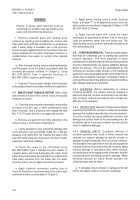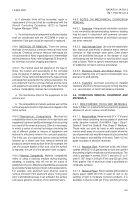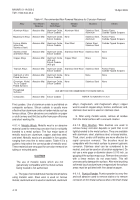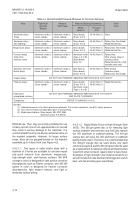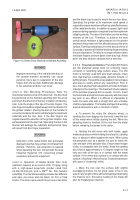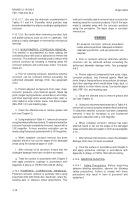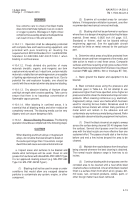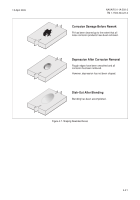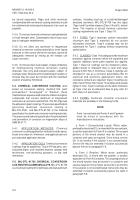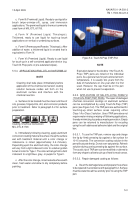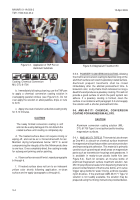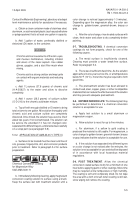TM-1-1500-344-23-2 - Page 94 of 240
4-18
NAVAIR 01-1A-509-2
TM 1-1500-344-23-2
15 April 2009
4-10.1.2.7. Use only the materials recommended in
Tables 4-1 and 4-4. Dissimilar metal particles may
become embedded in surfaces, leading to rapid galvanic
corrosion.
4-10.1.2.8. Be careful when removing corrosion from
soft plated surfaces (such as zinc or cadmium). Soft
plating is easily damaged or removed by mechanical
methods.
4-10.2. NON-POWERED CORROSION REMOVAL.
This method is accomplished by hand rubbing the
corroded surface with tools or abrasives to remove the
corrosion. This method is normally used to remove mild
surface corrosion by scraping or wearing away the
corrosion products and some base metal. The basic
steps are:
a. Prior to removing corrosion, determine whether
corrosion can be removed without exceeding the
authorized allowable damage limits. See paragraph
4-8.3.
b. Protect adjacent components from scale, chips,
corrosion products, and chemical agents. Mask lap
joints, hinges, faying surfaces, access doors, air scoops,
and other openings which would allow chips, dust, or
other debris to enter interior areas. Use barrier paper
(MIL-PRF-131) and masking tape.
c. Clean the affected area to remove grease and
soil (see Chapter 2).
d. Using materials in Table 4-1, remove all corrosion
using the mildest effective method. To determine whether
corrosion has been completely removed, inspect with a
10X magnifier. A more sensitive evaluation can be
made using fluorescent penetrant with a 10X magnifier.
e. When complete corrosion removal has been
attained, blend or fair out the edges of the damaged
areas using fine abrasive paper or cloth.
f. After removal of all corrosion, ensure that the
allowable damage limits have not been exceeded.
g. Treat the surface in accordance with Chapter 5
and apply protective coatings in accordance with
Appendix A (Navy) or TM 55-1500-345-23 (Army).
4-10.3. POWERED CORROSION REMOVAL.
Powered corrosion removal is generally done using
pneumatic drills with bristle disc, flap brush, rotary file,
sanding pad, or abrasive wheel attachments. This
method is normally used to remove heavy corrosion by
wearing away the corrosion products. Part of the base
metal is abraded away with the corrosion products
using this procedure. The basic steps in corrosion
removal are:
WARNING
All powered corrosion removal procedures
create airborne particles. Adequate ventilation,
respiratory protection, and eye protection are
required.
a. Prior to corrosion removal, determine whether
corrosion can be removed without exceeding the
authorized allowable damage limits. See paragraph
4-8.3.
b. Protect adjacent components from scale, chips,
corrosion products, and chemical agents. Mask lap
joints, hinges, faying surfaces, access doors, air scoops,
and other openings which would allow chips, dust, or
other debris to enter interior areas. Use barrier paper
(MIL-PRF-131) and masking tape.
c. Clean the affected area to remove grease and
soil (see Chapter 2).
d. Using only recommended materials in Table 4-4,
remove all corrosion using the mildest effective method.
To determine whether corrosion has been completely
removed, it may be necessary to use fluorescent
penetrant inspection with a 10X magnifier.
e. When complete corrosion removal has been
attained, blend or fair out the edges of the damaged
areas using fine abrasive paper or cloth (see paragraph
4-11).
.
f. After removal of all corrosion, ensure the allowable
damage limits have not been exceeded.
g. Treat the surface in accordance with Chapter 5
and apply protective coatings in accordance with
Appendix A (Navy) or TM 55-1500-345-23 (Army).
4-10.4. ABRASIVE BLASTING.
4-10.4.1.
Safety Precautions. Before beginning
abrasive blasting operations, observe the following
safety precautions. Failure to comply with these
precautions may result in harm to personnel and
equipment.
Back to Top

